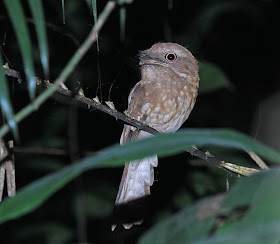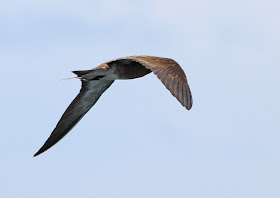Krau Biodiversity Centre, set in Krau Game Reserve, isn't a bad place to be if you have to attend a training course! Even though the course kept us busy for most of the daylight hours, I still managed to squeeze a couple of hours in here and there at the beginning and ending of each day.
Early morning walks were productive for frogmouths, with this confiding Gould's perched about 5 feet off the ground...
And a splendid pair of Large Frogmouths put on a fantastic show. This was the brighter-plumaged and more aggressive of the pair, so I assumed he was the male. This rear view shows faint "ear tufts" and a prominent nape line.
This is him reacting strongly when I played his call back.
Early morning walks were productive for frogmouths, with this confiding Gould's perched about 5 feet off the ground...
And a splendid pair of Large Frogmouths put on a fantastic show. This was the brighter-plumaged and more aggressive of the pair, so I assumed he was the male. This rear view shows faint "ear tufts" and a prominent nape line.
This is him reacting strongly when I played his call back.
The second bird was greyer and much less strongly marked. I judged this to be the female of the pair.
A comparison with the other bird.
In BirdingASIA 14, Tan Gim Cheong and Yong Ding Li mention the following plumage differences in a breeding pair:
1. The well-marked bird (presumed male) showed white traingular marks on the wing coverts with little or no black edging. The other (duller) bird showed more tear-drop shaped covert spots, edged with more black.
2. The scapulars were tipped black on the duller bird, but had black subterminal spots and buff tips on the brighter bird
3. The brighter bird had more well-defined pale buff brows than the other.
All three of these differences can be discerned in the two photos above, suggesting that these may be consistent plumage differences between the sexes.
Apart from the typical growling calls, both birds gave chicken-like clucks, which appeared to be alarm or threat calls uttered in response to my playback.
1. The well-marked bird (presumed male) showed white traingular marks on the wing coverts with little or no black edging. The other (duller) bird showed more tear-drop shaped covert spots, edged with more black.
2. The scapulars were tipped black on the duller bird, but had black subterminal spots and buff tips on the brighter bird
3. The brighter bird had more well-defined pale buff brows than the other.
All three of these differences can be discerned in the two photos above, suggesting that these may be consistent plumage differences between the sexes.
Apart from the typical growling calls, both birds gave chicken-like clucks, which appeared to be alarm or threat calls uttered in response to my playback.
Also out and about early were swiftlets which were clearly different from the familiar pale-rumped Germain's which I see regularly at sea and around swiftlet farms. I assume that these were Black-nest Swiftlets.
These birds were greyer overall (notwithstanding the lack of light), with barely notched tails. The wings appeared to be set slightly further forward on the body, with a longer tail projection (very thin when in profile) and a shorter head projection than on Germain's. The head was noticeably larger than Germain's - an impression in the field borne out by comparison of photos:
Black-nest Swiftlet. Note the neckless appearance and large domed head profile.
Germain's Swiftlet seen off Tanjung Dawai on 10th May. The wings seem more central, there seems to be more neck, and the head is small, typically with a flat head profile.
A few more birds of note - a blue morph Rufous-winged Philentoma.
An Olive-winged Bulbul.
And an overflying Large Green-pigeon at dusk.
I enjoyed a few days catching up with my old birding friend Mike Chong. On the morning after the course, we spent a fruitful morning birding along the road. After an hour's separation, I returned to find that Mike had been watching a family party of Grey-and-buff Woodpeckers over his head for five minutes! In case you don't know, G and B W is (and remains) my No. 1 bogey bird in Malaysia!






























































